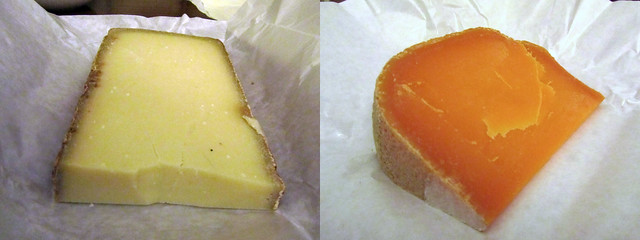29 Feb 2012 10
The Cheese Diary: February 2012
The quest in cheese tasting continues. This month, there were a couple of French and a couple of Swiss cheeses on the plates. Given the spirit that kick started this project, you must be wondering why I am not devouring only French cheeses and have instead grabbed some Swiss produce at the same time. Well, some of these cheeses are popular and when it comes to food, sometimes, it is hard to stop at the modern border. Consider though, historically, by region, then I guess (or so I hope) I’m not too far off in my mission. ;)

Week 5: Gruyère
Originated from the canton of Fribourg in Switzerland, Gruyère is a hard pressed-and-washed cheese made from cow milk. Its aging time typically runs for a few months and the longer it’s cured, the more complex its flavour. With rusty brown rind and pale cream pâte, the cheese cracked relatively easily when cut into and its texture in the mouth felt dry and somewhat crumbly. It tasted nutty yet sweet, of which this sweetness reminded me of P’tit Basque from a couple of weeks ago. It is a handsome cheese by all means, although I suspect this wedge that we’ve got is a middle-age affinage variety. I should have grabbed some grand cru variety too for a comparison.
Week 6: Mimolette
There is a small disagreement of the origin of this cheese. A couple of my friends believe it’s Dutch but it’s supposed to be French, from the northern city of Lille. It is, however, made to imitate Edam, except it has orange flesh (Edam is in creamy shade of yellow) with rind of soft sand colour. Its shape is a tad particular, nearly melon-like when whole. Yet another hard cheese, and I think we’ve gone to the other extreme to last week, choosing one that was rather aged, because it was really hard to cut into it and likewise, eating it. Taste-wise, it was nutty but relatively mild nonetheless. Not particularly memorable, I’m afraid, but I was told this was not a good wedge of mimolette. Perhaps I shouldn’t write it off just yet.

Week 7: Tête de Moine
This cheese comes in a very pretty serving. Pretty? Yup. Pretty. Massive thanks to Chloé* for picking this up just so I can try it! carnation-like cuteness to boot. Swiss in origin, the name of the cheese means “a monk’s head”, a hat tip to the original producer of this cheese – monks of the abbey of Bellelay. It is cylindrical in shape, but in order for the flavour to develop, it is “cut” circularly using a girolle, then gathered together, resembling the flower carnation. The thin slicing method meant the texture of cheese in hold was soft and pliable, and it quite melt in your mouth. The flavour of the cheese was rather complex, aromatic yet nutty (sorry, I am not quite the turophile yet to be able to describe it properly). A joy to behold and a delight to taste.
Week 8: Beaufort
Back to another hard cheese this week (I need to expand to other type of cheese soon) Beaufort is a hard cheese from cow’s milk and it is very similar to Gruyère but with longer affinage time (double that of Gruyère). Its shape is a tad particular, as the mold in which Beaufort is pressed in has a concave shape to give it “heel”. In addition to the distinctive heel, its rind is brown in colour and it has yellow pâte. Texturally it is rather smooth in the mouth but there’s a spicy note to it, which took me by surprise. There’s complexity to the flavour too, but I’m not entirely sure if it’s to my taste. I’m on the fence for now.
* On an important note, I must also say many thanks to Frédéric. Between him and Chloé, they have been the biggest supporters of this project thus far. Not only are they going the extra mile to get cheeses for me to try, they’re essentially funding the cheese tasting for each and every time they bought yet another variety – which is pretty much all the time! I am a very very lucky girl. :D














